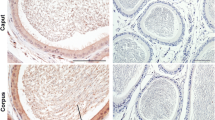Summary
The distribution of specific nuclear binding sites for androgens and estrogens in the male accessory sex organs of the mouse was assessed by autoradiography with3H dihydrotestosterone (3H DHT) and3H estradiol (3H E2).
With3H DHT nuclear labeling differed among the epithelia of the organs. It was high in seminal vesicle and ampullary gland, moderate in ventral prostate, urethral gland, prostatic excretory ducts and the ampulla ductus deferentis, low in dorsal prostate and low or absent in coagulation gland. With3H E2, in contrast, epithelial nuclear labeling was high only in coagulation gland, moderate or low in seminal vesicle, low or absent in ventral and dorsal prostate and absent in ampullary gland and ampulla ductus deferentis. In the lamina propria of all organs nuclear labeling with3H DHT was generally moderate and existed only in some cells, with the highest number in the ampulla ductus deferentis. With3H E2, nuclear labeling in the lamina propria showed a high intensity in all organs, except in ventral and dorsal prostate which remained unlabeled. Many labeled cells were found in the deferent duct and its ampulla, while in the other organs only a few cells showed nuclear labeling with3H E2. In the smooth muscle sheath of all organs, some muscle cells were moderately labeled with3H DHT, but not with3H E2.
The results indicate the presence of nuclear receptors in male accessory sex organs for both dihydrotestosterone and estradiol. The differential patterns of3H DHT and3H E2 nuclear uptake suggest differential sensitivities of the individual organs and their tissue compartments for androgens and estrogens.
Similar content being viewed by others
References
Allen JM (1956) The influence of hormones on cell division. 1. Time-response of ear, seminal vesicle, coagulation gland and ventral prostate of castrate male mice to a single injection of estradiol benzoate. Exp Cell Res 10:523–532
Andersson H, Tissell LE (1982) Morphology of rat prostatic lobes and seminal vesicles after long term estrogen treatment. Acta Pathol Microbiol Immunol Scand (A) 90(6):441–448
Blondeau JP, Corpechot C Le Goascogne C, Baulieu EE, Robel P (1975) Androgen receptors in the rat ventral prostate and their hormonal control. Vitam Horm 33:319–345
Boesel RW, Klipper RW, Shain SA (1980) Androgen regulation of androgen receptor content and distribution in the ventral prostate of aging AXC rats. Steroids 35:157–177
Bouton MM, Pomin C, Grandadam JA (1981) Estrogen regulation of rat prostate androgen receptor. J Steroid Biochem 15:403–408
Burrows H (1935) Pathological conditions induced by oestrogenic compounds in the coagulation gland and prostate of the mouse. Am J Cancer 23:490–512
Cattanach BM, Pollard CE, Hawkes SG (1971) Sex-reversed mice: XX and XO males. Cytogenet Cell Genet 10:318–337
Drews U (1975) Direct and mediated effects of testosterone: The development of intersexes in sex reversed mice, heterozygous for testicular feminization. Anat Embryol 146:325–340
Dubois R, Dube JY, Tremblay RR (1980) Presence of three different estradiol binding proteins in rat prostate cytosol. J Steroid Biochem 13:1467–1471
Fang S, Liao S (1969) Antagonistic action of anti-androgens on the formation of a specific dihydrotestosterone receptor protein complex in rat ventral prostate. Mol Pharmacol 5:428–431
Horning FS (1947) The action of diethylstilboestrol on the prostatic epithelium of the mouse. Lancet 251:829–830
Hummel KP, Richardson FL, Fekete E (1966) Anatomy. In: Green EL (ed) Biology of the laboratory mouse, 2nd edn. The Blakiston Division, New York Toronto, pp 247–308
Leav I, Merk FB, Ofner P, Goodrich G, Kwan PWL, Stein BM, Sar M, Stumpf WE (1978) Bipotentiality of response to sex hormones by the prostate of castrated and hypophysectomized dogs: direct effects of estrogen. Am J Pathol 93:69–85
McLaren A (1983) Sex reversal in mouse. Differentiation 23 (Suppl):93–98
Moore CR, Price D, Gallagher TF (1930). Rat prostate cytology as a testis-hormone indicator and the prevention of castration changes by testis extract injection. Am J Anat 45:109–135
Price D (1944) The development of reactivity in the accessory reproductive organs of castrated and spayed rats injected with testosterone-propionate. Physiol Zool 17:377–391
Price D, Williams-Ashman HG (1961) The accessory reproductive glands of mammals. In: Young WC (ed), Sex and internal secretions, 3rd edn. Williams and Wilkins Co, Baltimore, pp 366–488
Schleicher G, Drews U, Stumpf WE, Sar M (1984) Differential distribution of dihydrotestosterone and estradiol binding sites in the epididymis of the mouse. Histochemistry 81:139–147
Stumpf WE, Sar M (1975) Autoradiographic techniques for localizing steroid hormones. In: O'Malley BW, Hardman JG (eds) Methods of enzymology, vol 36. Academic Press, New York, pp 135–156
Stumpf WE, Sar M (1976) Autoradiographic localization of estrogen, androgen, progestin and glucocorticosteroid in “target tissues” and “non target tissues”. In: Pasqualini JR (ed) Receptors and mechanism of action of steroid hormones, part I. Marcel Dekker, New York, pp 41–84
Author information
Authors and Affiliations
Additional information
Supported by PHS grant NSO9914 to W.E.S. and Deutsche Forschungsgemeinschaft Dr94/4 to U.D. The work of Dr. Schleicher and his stay in Chapel Hill were additionally sponsored by Studienstiftung des Deutschen Volkes and Boehringer-Ingelheim Fonds
Rights and permissions
About this article
Cite this article
Schleicher, G., Stumpf, W.E., Drews, U. et al. Differential distribution of3H dihydrotestosterone and3H estradiol nuclear binding sites in mouse male accessory sex organs. Histochemistry 82, 453–461 (1985). https://doi.org/10.1007/BF02450480
Received:
Accepted:
Issue Date:
DOI: https://doi.org/10.1007/BF02450480




